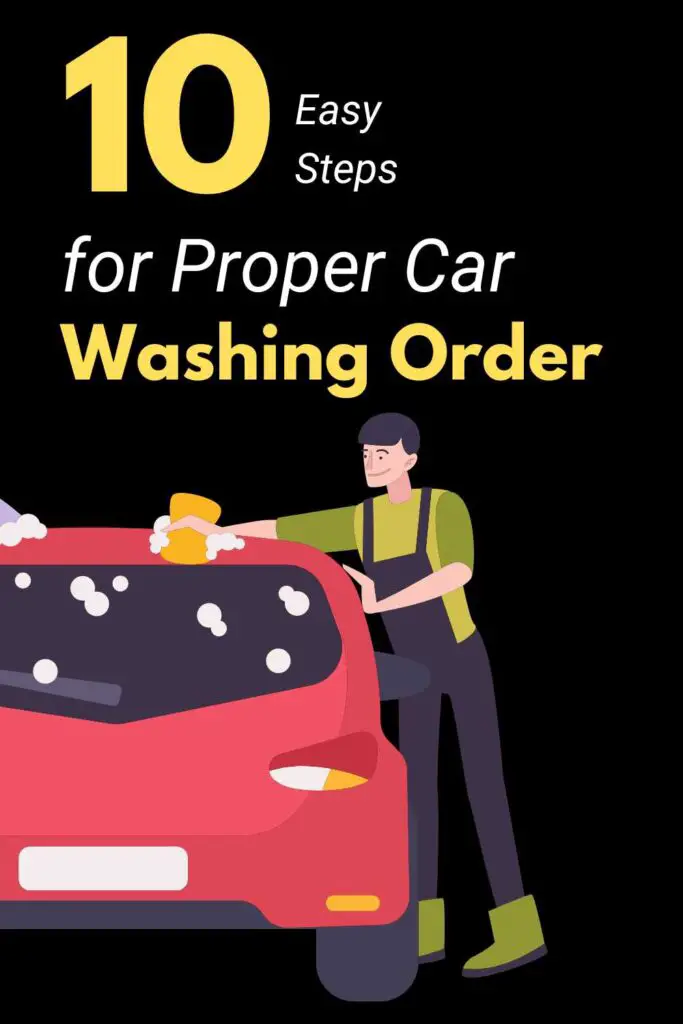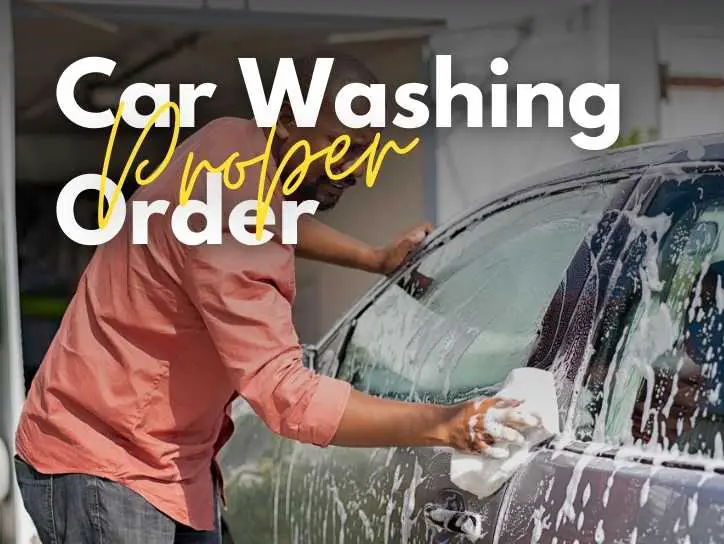Keeping your vehicle clean not only enhances its appearance but also helps protect its finish and prolong its lifespan.
While taking your car to a professional car wash is convenient, many car owners prefer to wash their vehicles at home for a more personalized touch.
However, to achieve the best results and avoid potential damage to your car’s exterior, it’s essential to follow a systematic approach.
In this article, I’ll walk you through the proper order and steps to wash your car at home or any suitable location. By following these instructions, you can maintain your car’s beauty and ensure it remains in tip-top condition.
So, let’s get started on a clean and shiny car.
Importance of Washing Your Vehicle in Proper Order
- Effectiveness: It ensures thorough cleaning
- Damage Prevention: Minimizes the risk of scratches
- Time Efficiency: Saves time by avoiding rework
- Consistency: Maintains your vehicle’s appearance
- Protection: Preserves the paint and finish
- Enhanced Appearance: Keeps your car looking its best
- Longevity: Extends the life of your vehicle
- Pride of Ownership: Reflects well on the owner and fosters pride in car maintenance
Steps to Follow for Proper Car Washing Order
1. Gather your supplies
Before you start washing your car, I suggest gathering all the necessary supplies, including a bucket (out of two bucket method), car wash soap, a hose with a nozzle or a pressure washer, microfiber or soft mitts/sponges, a separate bucket for rinsing, a wheel brush, a drying towel or chamois, and any other specialized cleaning products you might need for your specific car care needs.
2. Park the Vehicle in a Shaded Area
It’s best to wash your car in a shaded area or during a cooler part of the day to prevent the soap from drying too quickly on the surface.
3. Rinse the Car

Begin by thoroughly rinsing the entire car with water to remove loose dirt like dust and debris. For this step, you should use a hose with a nozzle or a pressure washer. Ensure you rinse the wheels and tires as well.
It is important to check and clean the engine bay area and take special care of the electronics during rinse.
4. Clean Wheels & Tires

Follow the bucket method to clean the wheels and tires first because they tend to be the dirtiest part of the car. Use a wheel brush and specialized wheel cleaner to scrub away brake dust and grime. Rinse thoroughly.
You can also wash the vehicle’s underbody.
5. Pre-soak & Wash
Fill one of your buckets with water and the recommended amount of car wash soap. Use a separate bucket for rinsing. Start at the top of the car and work your way down to the window, hood, sides, etc.
Use a soft mitt or sponge to apply soapy water to one section of the car at a time, starting with the roof and working your way down to the sides, front, and rear. Avoid using excessive pressure when scrubbing to minimize the risk of scratching the paint.
Note: Please ensure the washing mitt is not dirty.
6. Rinse
After washing a section, rinse it thoroughly with clean water from the second bucket or use the hose. Make sure all soap and dirt are completely removed.
7. Repeat
Continue the washing and rinsing process section by section until you have cleaned the entire car.
8. Dry
Use a clean and soft drying towel to dry the car. Start at the top and work your way down areas to prevent water spots.
9. Detailing (optional)

After your vehicle is dry, you can use specialized products for detailing such as wax or polish to enhance the shine and protection of the paint.
10. Final Touches
Don’t forget to clean the windows, mirrors, and any other glass surfaces separately, using a glass cleaner. You can also apply tire shine polish for a finished look.
Please follow the manufacturer’s recommendations for any specific car care products you use and use gentle, non-abrasive materials to avoid scratching the paint or damaging the finish.
Additionally, always wash your car with clean tools to prevent introducing dirt or debris that could scratch the surface.
Related Facts & Stats
- Car Washing Frequency: Most car owners wash their vehicles about once a month.
- Environmental Impact: Home car washing can release pollutants into the environment, while professional car washes often have water reclamation systems.
- Water Usage: At-home car washes use 80-140 gallons (300-530 litres) of water, while professional car washes are more water-efficient.
- Damage from Improper Washing: Improper washing techniques can lead to swirl marks and paint damage, a common cause of vehicle paint damage.
- Car Resale Value: Well-maintained and clean cars tend to have higher resale values.
- UV Protection: Regular washing and waxing protect against UV radiation damage to a car’s paint.
- Time Investment: Home car washing can take 30 minutes to a few hours, depending on the car’s size and level of detail.
- Seasonal Considerations: Frequent winter washing is crucial to remove corrosive road salt.
- Professional Detailing: Many car owners opt for professional detailing services for extensive cleaning and restoration.

Related Questions
Is it better to wash your car at home or a car wash?
It depends on your preferences and circumstances. Washing your car at home allows you to have complete control over the process and use the products you trust. However, it requires time, effort, and access to necessary equipment. On the other hand, a professional car wash may be more convenient and efficient but could be more expensive. It’s essential to follow proper techniques and use appropriate products, regardless of where you wash your car, to avoid damaging the paintwork.
Do you need to wash your car regularly or only when it needs it?
Regular car washing is recommended to prevent the buildup of dirt, grime, and contaminants on the paint surface. How often you should wash your car depends on factors such as local climate, driving conditions, and personal preferences. Typically, washing your car every 2-4 weeks is a good starting point, but you may need to do it more frequently if it gets exposed to harsh conditions or accumulates dirt quickly.
What should you use to wash a car without damaging the paintwork?
To wash a car without damaging the paintwork, use a pH-balanced car wash soap and a soft mitt or sponge. Avoid household detergents, as they can strip wax and harm the paint. Also, use a separate bucket for rinsing and clean, non-abrasive towels or microfiber cloths for drying.
How often should I wash my car?
As mentioned earlier, washing your car every 2-4 weeks is a general guideline, but you may need to adjust based on your specific circumstances.
I use my car once a week. How often should I wash my car?
If you use your car once a week, you may not need to wash it as frequently as someone who drives more often. However, dust, bird droppings, and other contaminants can still accumulate. You might consider washing it every 2-4 weeks, but adapt it to your car’s actual condition.
Is it worth washing your car or is it better to pay at a car wash?
The choice between washing your car and using a professional car wash depends on your preferences, available time, and budget. Washing your car can be a cost-effective option, especially if you enjoy taking care of your vehicle. Professional car washes offer convenience and may use specialized equipment and products. Both methods can be effective if done correctly.
Why is the order of washing a car important?
The order is crucial because it helps ensure an effective and safe cleaning process. Starting from the top and working your way down prevents dirt and contaminants from higher areas of the car from flowing down and re-contaminating the lower sections. It also minimizes the risk of scratching the paintwork by following a logical sequence.
Should I wash my car’s wheels before or after the rest of the car?
It’s best to clean the wheels and tires first. Wheels tend to be the dirtiest part of the car due to brake dust and road debris. Cleaning them first prevents splashing dirt and grime onto the clean body panels and ensures thorough cleaning of the wheels.
Should I wash my car in direct sunlight or find a shaded area?
It’s better to wash your car in a shaded area or during a cooler part of the day. Washing in direct sunlight can cause the soapy water to dry quickly on the surface, potentially leaving water spots and making the washing process more challenging.
Do I need to dry my car after washing it?
Yes, drying your car is essential to prevent water spots and maintain its appearance. Use a clean and soft drying towel or chamois to remove excess water, starting from the top and working your way down. Drying immediately after washing helps achieve a streak-free finish.
Should I apply Wax or Polish after washing my car?
Applying wax or polish after washing your car is optional but recommended. These products can enhance the shine, provide additional protection to your car’s paint, and help maintain its finish over time. Waxing every few months can help preserve the paint’s lustre and protect it from environmental factors.
Conclusion
With my suggested step-by-step instructions, you now have the knowledge and confidence to wash your car effectively and safely.
Regular car washing not only improves your vehicle’s appearance but also protects it from environmental effects, ensuring it stays in excellent condition for years to come.
Remember to gather the necessary supplies, work from top to bottom, and use gentle, non-abrasive materials to prevent any potential damage to your car’s finish.
Taking care of your car through proper maintenance, including regular washing, is a rewarding endeavour that can help maintain its value and keep it looking its best.
Whether you’re a car enthusiast or simply want to ensure your vehicle’s longevity, a clean and well-maintained car is a source of pride and satisfaction.
So, roll up your sleeves and enjoy giving your car the care it deserves. Please drop your suggestions and questions in the comment section below.
